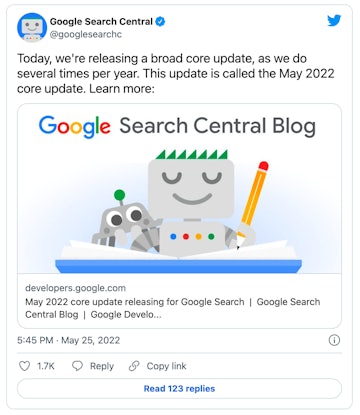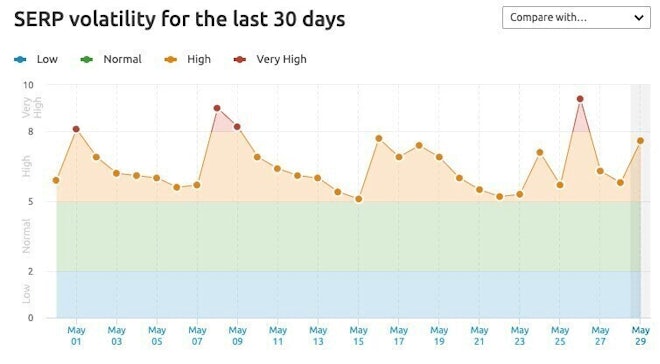May saw the roll out of a core algorithm update – which has now officially completed. We’ve covered who the winners and losers are of this update, plus looking at the impact it has had. Amongst this major update, we’ve also covered other topics such as Google retracting information from their online certifications.
The usual traffic light system is in place to differentiate the updates that need immediate attention from those that are less pressing. Red light updates are major changes that should be factored in straight away; amber is for updates that you should take note of (but which may not need any urgent action), and green updates are still worth knowing about, yet less critical than the others.
Keen to know more about any of these changes and what they mean for your SEO? Get in touch or visit our SEO agency page to find out how we can help.
Google Core Update May 2022 (LHa)

On the 25th of May 2022, over six months since the last core update in November last year, Google announced it was rolling out the first core update of the year – the May 2022 Core Update.

What was the initial impact of May’s core update?
According to Semrush, there was a significant spike in SERP volatility a day Google announced the update, although similar to the volatility experienced after the November 2021 Core Update, this only lasted a day and returned to normal levels a couple of days into the update rolling out. It appears that Google is adopting a much quicker initial increase in ranking volatility during core updates, and that the impact of the updates is becoming less pronounced.

How Volatile Was the May 2022 Core Update?
Although the November 2021 Core Update was not considered to be particularly disruptive in terms of volatility, Semrush’s analysis of the two most recent updates shows that the May 2022 Core Update had a much less dramatic impact on the baseline level of volatility that existed before the update, suggesting that it was not as disruptive as past updates.
Which industries were impacted most?
Measuring the impact on an industry level, Semrush analysed 18 verticles, of which only the real estate industry saw a bigger change in rank volatility during the May 2022 update compared to November 2021, although there were no fluctuations that indicate this update targeted specific niches.

The industries that experienced the largest increase in desktop ranking volatility were:
- Real Estate
- Books & Literature
- Hobbies & Leisure
- Travel
- Pets & Animals
The industries that experienced the largest increase in mobile ranking volatility were:
- Real Estate
- Pets & Animals
- Hobbies & Leisure
- Books & Literature
- Health
Qualifying the Impact of the May 2022 Core Update
It is still too soon to understand the full impact of the update, as changes continue to take shape over time. To get a sense of the initial impact and scope of the May 2022 core update, Semrush investigated where newly ranking URLs came from if they appeared in the top 10 following the update. They found that 6.7% of top 10 results were previously ranked beyond position 20. This figure is fairly typical for a core update and would suggest that there were some significant ranking shifts in May.
Looking at the data further, we can see that over 17% of URLs among the top 20 results came from beyond position 20 itself. This is very similar to the levels we saw following the November 2021 Core Update where 16.2% of new URLs within the top 20 results ranked beyond position 20 prior to the update.
Average Gains and Losses During the May 2022 Core Update
To get a better understanding of just what positive and negative impacts the May update had, we can take a look at the top 100 websites that saw the biggest losses and gains for the following picture:
- The May update winners gained around 31.4 positions, with an average position of 10.2. For context, November’s winners gained 33.6 positions.
- Those that were most heavily impacted by the update lost around 34.9 positions. In November, they lost 27.6 positions.
What does this mean for me?
As this update is still rolling out, it is hard to say what the final impact of the May 2022 Core Update will be, although given the trends we saw with the November and July Core Updates in 2021, it is likely that ranking volatility will remain stable until the next core update.
Site owners that have seen noticeable increases or decreases in rankings should not expect to see any major changes in rankings outside of normal fluctuations until the next core update and can read Google’s advice around core updates for more information.
As with every core update, Google also places a greater emphasis on quality content, so a good way to mitigate any disruption caused by every algorithm update is to keep creating great content and perfect your existing pages.
If your site has been negatively affected, take a look at our guide to recovering from an algorithm update for a step-by-step place on action.
Google Erased The Keyword Density Slide From Digital Marketing Certification Coursework

Recently, Google launched its official Google taught and sponsored digital marketing certification and courses. In the course, there were SEO tips and suggestions including the advice that content creators should be including more than 300 words on a page and ensure that their keyword density is about 2%.

This advice was then quickly contradicted – with other search experts from Google claiming that this is not best practice. For example, Danny Sullivan on Twitter – who said:
I’m not on the team that produced that, nor are they part of the Search team. As someone from the Search team, we don’t recommend any limits or “density” or anything like that. This can be ignored; I’ll pass it on. Our advice from Search is here.
Within a day, Google changed its stance on keyword density and word count and erased this slide of information from their course. Google now says that there is no minimum density that is required for a page to rank well.
What does this mean for me?
It does beg the question, what else in Google’s digital marketing coursework could potentially be encouraging bad practice based on what we have seen so far.
Keep yourself up to date with official Google updates related to SEO by always checking guidance on Google Search Central.
For any further information about these posts – or to learn how we can support your SEO – get in touch today.



